How to Make Comfrey Oil and Healing Comfrey Ointment Balm
Welcome! This article contains affiliate links, meaning I get a commission if you decide to make a purchase through my links, at no extra cost to you.
Comfrey is one of my favorite plants with its delicate flowers and hairy leaves.
It lures snails away from my spinach, drops its leaves, and nourishes the earth, and grows so vigorously that it out-competes weeds. And that’s only the tip of the iceberg!
I’ve used a comfrey poultice to treat an extensive burn on a human and a swollen tendon on a horse.
I’ve turned it into oil that helps ease aching muscles, and a balm that makes quick work of minor wounds, relieves pain, and reduces inflammation.
Why you wouldn’t make your own comfrey salve, if you’ve got access to this resilient plant, I just don’t know. It’s quick, easy, and cheap to make.
- 12 cuttings of Non-invasive Bocking-14 cultivar of comfrey; will not produce viable seeds...
- Bocking-14 comfrey is the most desirable cultivar for making compost tea to fertilize your...
- Use comfrey to recover from injuries more quickly; Ask your doctor about the many...
- Save money on fertilizer for your trees and plants; use comfrey leaves to turbo-charge...
- Save money on animal feed by supplementing your feed with comfrry. used worldwide as an...
Are the Leaves or Roots Best for a Comfrey Ointment?
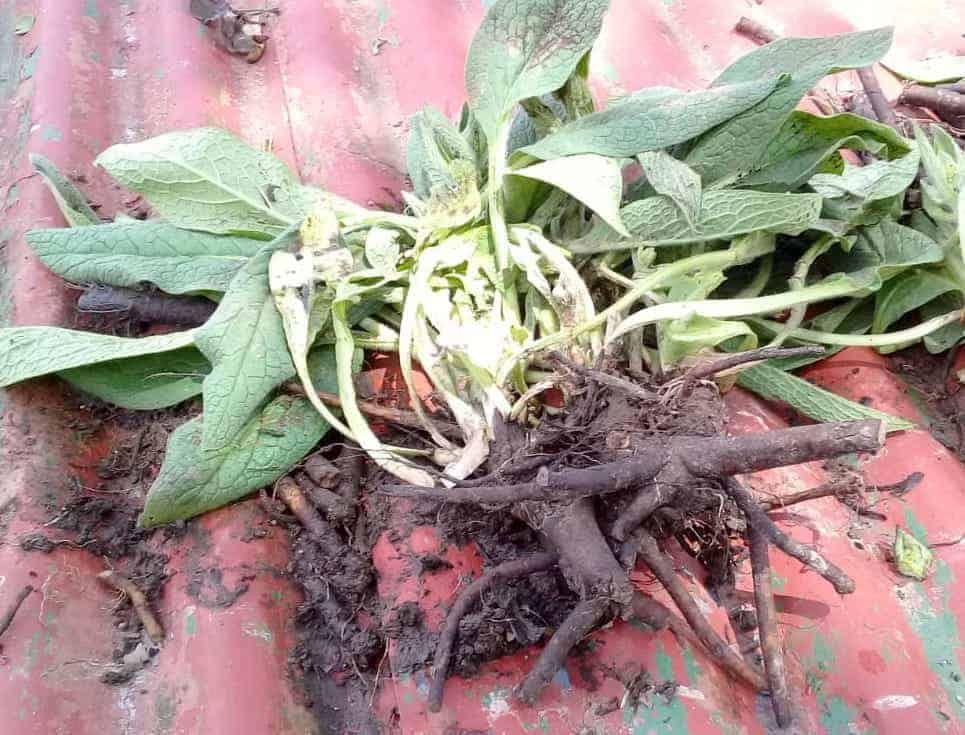
Most people use comfrey leaves to make their ointments or salves but, here at Peas on Earth’s small-holding in South Africa, we decided to boost its strength and efficacy by using the root instead.
Why? Because:
The allantoin content of comfrey, especially in the root, has resulted in its use in folk medicine for healing wounds, sores, burns, swollen tissue, and broken bones.” (source)
Yes, that’s right – comfrey can actually mend broken bones!
Its name is “derived from the Latin word for ‘grow together’” and, for a long time, it was commonly known as Knitbone.
What Do You Need to Make Comfrey Salve?
A healing comfrey salve is a simple concoction containing comfrey oil and beeswax. That’s it!
If you want a pleasant fragrance, you can add a few drops of essential oil, but we like to keep things pure so the balm is more versatile and can be used safely on both animals and children.
Don’t have comfrey growing yet?
You can buy comfrey root, comfrey leaves, comfrey oil, essential oil, and even the beeswax from Starwest Botanicals (with free shipping over $75!) so you can get started making your own comfrey ointment today!

Comfrey Oil Organic from: Starwest Botanicals Inc.
How to Make Comfrey Oil Using the Leaves
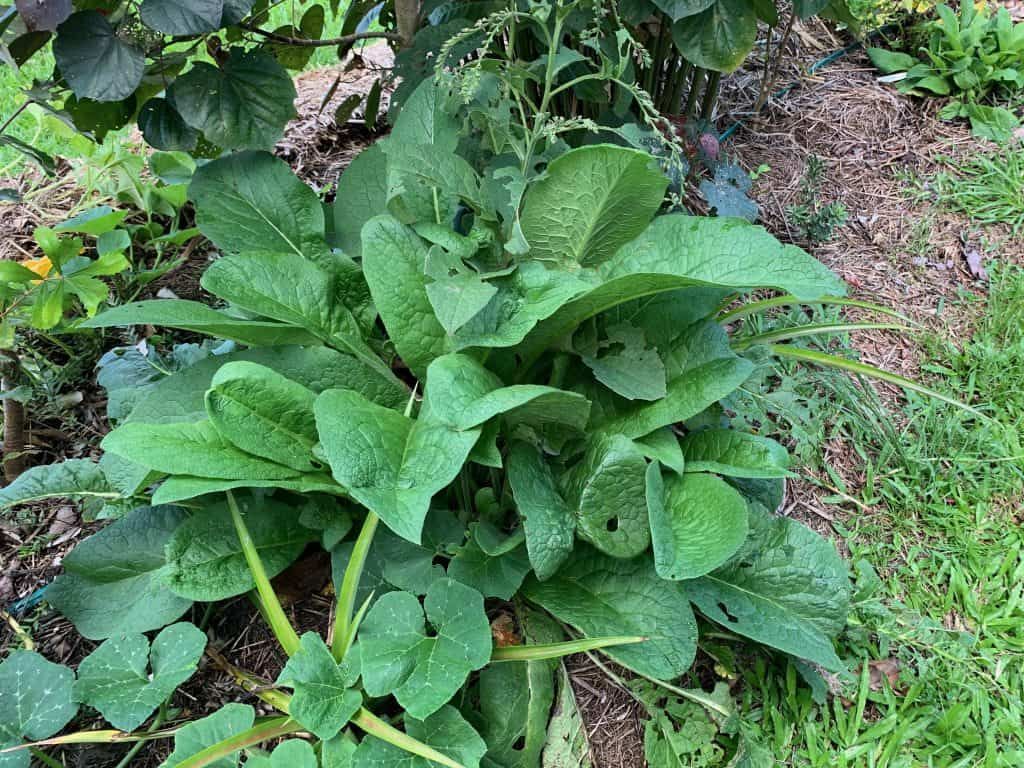
While you can make comfrey ointment using fresh leaves, because they are about 85% water, they only contain around 0.2% allantoin, making them less effective than dried leaves.
The high moisture content also has the potential to turn your oil rancid before it’s ready.
1. Harvest Your Comfrey Leaves
You can harvest comfrey leaves throughout the summer but not so much in winter when it tends to die off.
The best time to pick your leaves is on a flower day, so when the moon is in one of the air signs, like Aquarius, Gemini, or Libra. You’ll also get the best results and the most potent leaves if you harvest when the moon is ascending.
2. Dry the Leaves
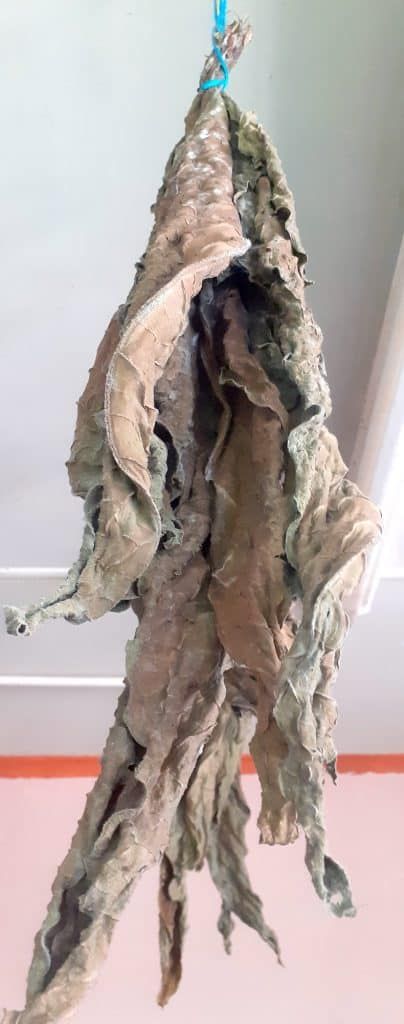
We used to have a small electrical dehydrator, a bit like this one, but we never used it for comfrey as they’re so easy to air-dry.
You can put your leaves into a dehydrator if you want to speed up the drying process or make your own drying rack, but hanging them also works effectively.
The leaves above have been hanging for several weeks and are now ready for the next stage.
3. Prepare Your Leaves
Crunch up your dried leaves, cutting up the stalks if necessary. By doing this you reduce the surface area of the leaves thereby increasing the potency of your oil.
Now pop your crushed leaves and stalks into a clean, dry glass jar.
4. Add the Oil
Once your leaves are in, it’s time to add the oil.
We’ve used grapeseed oil in the past and are currently using organic olive oil sourced from a local supplier. Other oils, like avocado and jojoba, are also effective, but substantially increase the cost of making your salve.
Pour your oil over your leaves, making sure it covers them all with at least half an inch of oil. This ensures that the leaves remain covered even when they soak up the oil and begin to expand.
5. Activate Your Comfrey Oil
While this step isn’t essential, it does, in my opinion, stimulate the process and activates the oil, resulting in a stronger, more potent product at the end.
Fill a bowl or pan with boiling water and put your jar with its oily, green contents into the water. Leave it there for about five minutes – just long enough for the oil to warm.
Take it out and dry it off and then give it a good shake.
6. Play the Waiting Game
Your oil is now ready to steep, so leave your jar on a sunny windowsill for about four to six weeks, giving it a shake every day.
7. Straining Your Comfrey Oil
When your oil is ready, strain out the mushed-up comfrey leaf using a mesh strainer or, better still, cheesecloth or a similarly loosely-woven fabric.
Pour the oil into another glass jar or tincture bottle and use it as necessary.
How to Make Comfrey Oil Using the Roots
This process is much the same as making comfrey oil from the leaves – the only thing that differs is the preparation of the plant.
1. Harvest Your Comfrey Root

Using a fork, loosen the soil around your chosen comfrey plant and expose the root.
Gently lift the roots out of the ground, watching for breakages. There is nearly always some root left behind which means a new plant will grow in due course, although it could take a couple of years if rainfall is low.
2. Clean the Roots
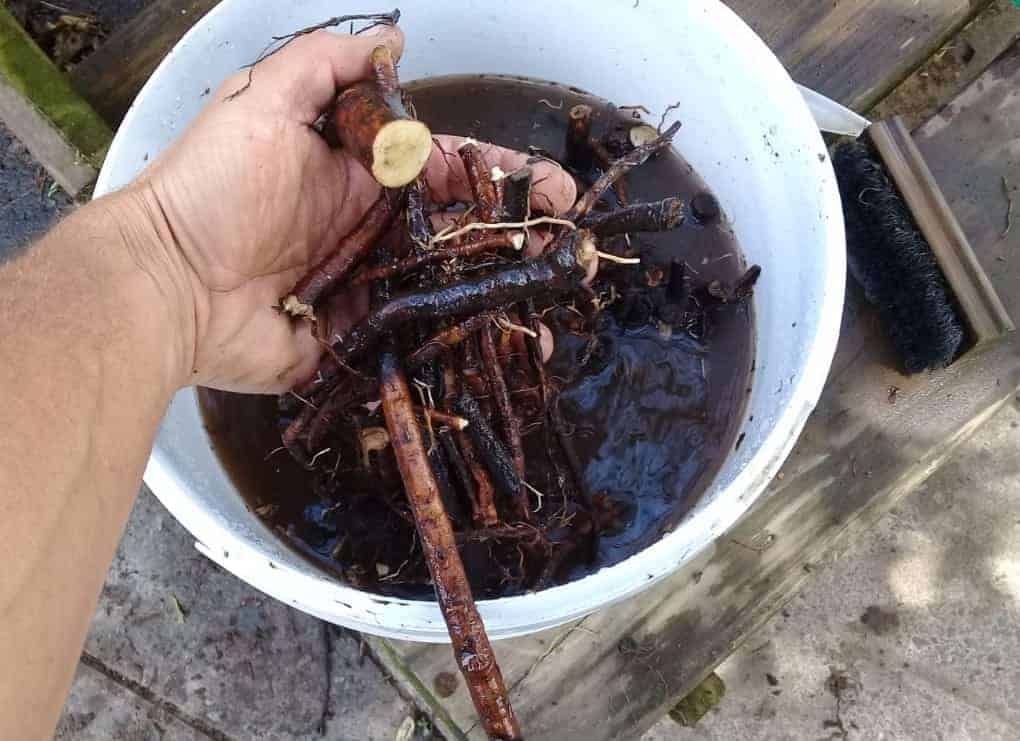
Remove the leaves from your roots and then place the roots into a large bowl of water. Use a soft scrubbing brush to gently remove the excess soil.
Comfrey roots have a strange, almost soapy texture, which can make handling them quite challenging but, I promise, it will be worth it.

3. Chop and Dry
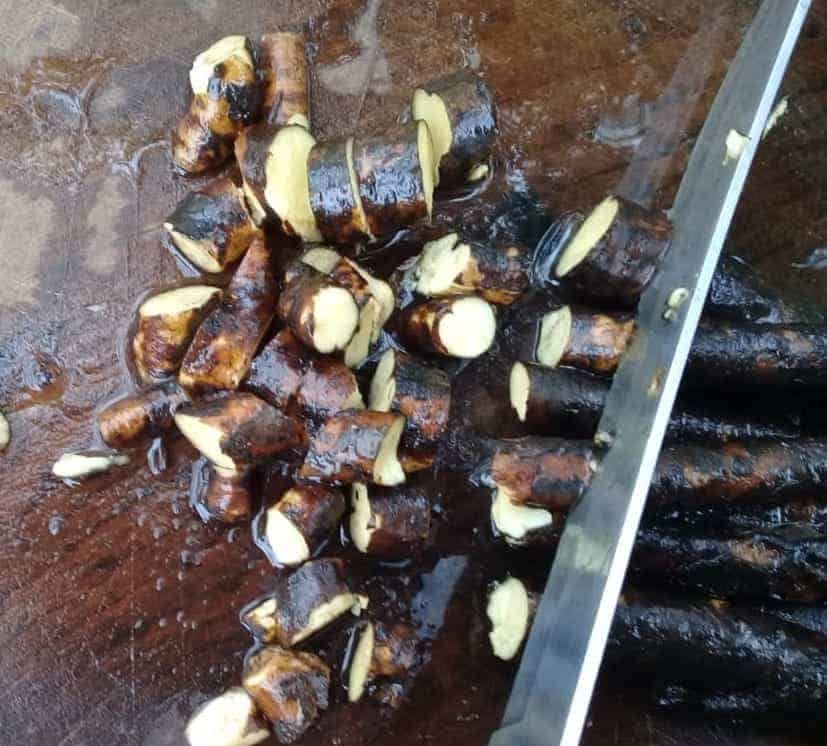
Once clean, chop the comfrey roots into small pieces, no bigger than around 1㎠.
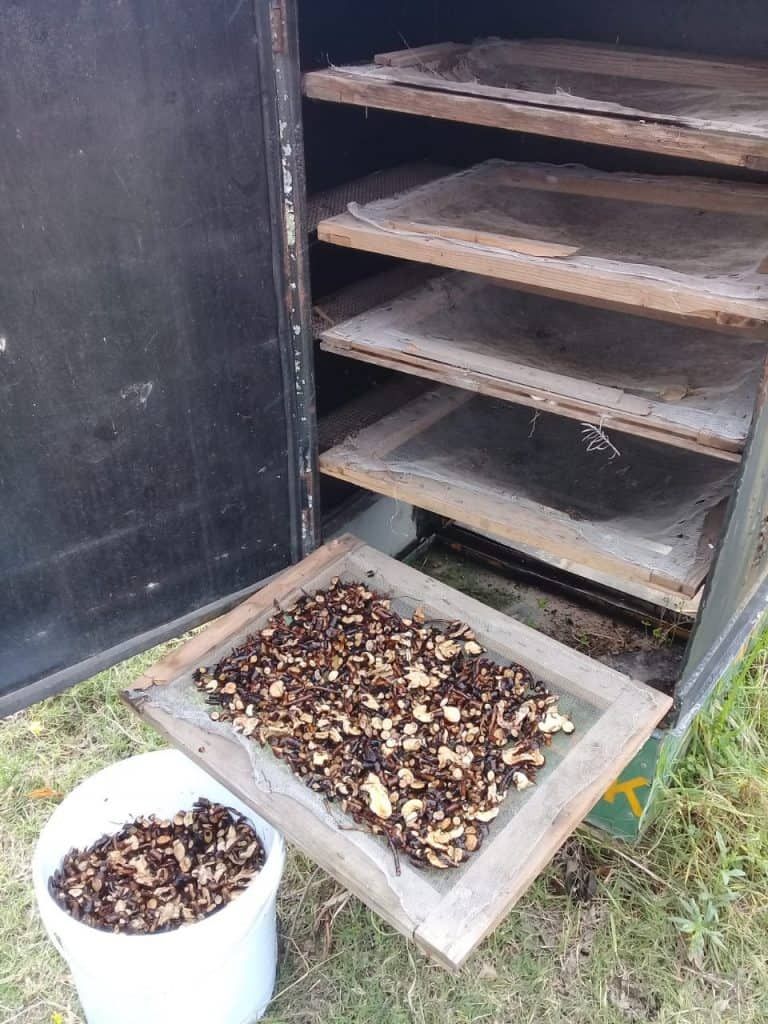
Spread the chopped-up root out on drying racks.
To speed things up a little, we put our drying racks into a homemade solar drier, where it takes between three to seven days for them to dry out. Obviously, the hotter the weather, the faster they dry.
The roots will turn black and take on a shriveled appearance while being hard to the touch, like chips of wood or pieces of bark.
Your roots are now ready to be transformed into oil!
Pop them into a jar and then follow steps 4 to 7 from the instructions above.
Why Is a Comfrey Ointment Better Than Just Using the Oil?
Now you’ve got some potent comfrey oil, try it out!
Rub into dry or irritated skin, aching joints, and sore muscles and see how effective it is. In doing so, you’ll also notice that it’s quite tricky to apply the oil without getting it everywhere, which is one of the reasons many people choose to take the next step and convert it into an ointment.
Not only is a comfrey salve easier to use, because the oil is combined with beeswax to create the right consistency, but a salve also contains all the benefits of beeswax, as well as the healing qualities of the comfrey oil.
Beeswax is “antifungal, antiviral, antiseptic and antibacterial.” For centuries, it’s also been used to treat burns, wounds, and skin conditions like eczema and psoriasis.
How to Transform Your Oil Into a Healing Comfrey Salve
Finally, we’ve reached my favorite part of the process – making the salve itself!
For many years, we used a 4:1 ratio of oil: beeswax, but we recently found that a 5:1 ratio creates a better texture and makes the salve more absorbent.
So, if you have 5 ounces of oil, you’ll need one ounce of beeswax. Once the weighing’s done and dusted, you’re ready to begin.
1. Melt the Beeswax
Using a double boiler or two pans, one on top of the other, melt the beeswax gently over boiling water.
2. Add the Oil
Once the beeswax is melted, pour the oil into the pan, stirring it constantly. Be careful to keep the heat low. You don’t want to overheat the oil as doing so could reduce its strength.
If you want to add a few drops of essential oil (lavender, oregano, tea tree, and yarrow are all excellent choices), do it just as you take the pan off the heat.
3. Decant the Salve

As soon as the oil and beeswax are fully combined into a golden liquid, decant the solution into small pots.
Leave the pots on one side with their lids off until the solution has solidified. Once hardened, your salve is ready for the next burn, sprained ankle, bee sting, or graze.
Stored in a cool place in a container with an airtight lid, a comfrey salve can last up to two years.
Why Is Comfrey Illegal In Some Countries?
Oral comfrey products have been banned in numerous countries, including the USA, Australia, Canada, Germany, and the UK. Comfrey contains “toxic substances called pyrrolizidine alkaloids” that can “cause liver damage, lung damage, and cancer” if taken internally.
However, the banning of comfrey may not be entirely justified. In Isabell Shipard’s book, How Can I Use Herbs In My Daily Life, she provides many sources of research and evidence that alkaloids were not found.
For example, Susan Weed, an American author and lecturer, said:
Numerous samples of comfrey from different areas of USA were laboratory tested for the problematic alkaloids and none were found.
She stresses that the research done by the Henry Doubleday Research Association (HDRA) resulted in a hybrid Symphytum species, which is free of the alkaloid said to cause health issues.
Isabell mentions it would be more appropriate to have the botanical name of the hybridized Comfrey variety changed from Symphytum officinale to Symphytum uplandicum x peregrinum, which would get rid of any confusion caused and make comfrey available again to everyone.
The hybridized strain “Bocking 14” is one of the heaviest cropping comfrey varieties. Yields of 40 to 67 tons of leaves per acre have been recorded! Isabell also states that Bocking 14 “is said to have the highest content of allantoin, which is the healing component of comfrey.”
- 12 cuttings of Non-invasive Bocking-14 cultivar of comfrey; will not produce viable seeds...
- Bocking-14 comfrey is the most desirable cultivar for making compost tea to fertilize your...
- Use comfrey to recover from injuries more quickly; Ask your doctor about the many...
- Save money on fertilizer for your trees and plants; use comfrey leaves to turbo-charge...
- Save money on animal feed by supplementing your feed with comfrry. used worldwide as an...
Is Comfrey Balm Legal?
Even in countries where oral comfrey products have been banned, ointments, balms, and salves are legal and often available over the counter. Now you know how to make your own, however, there’s no need to waste your hard-earned cash buying it.
Use Your Comfrey Ointment for People and Animals
I love making comfrey salve almost as much as I love how effective it is at treating sore muscles and persistent back pain.
I use it on my horses for minor wounds, scratches, and irritations, and on my dogs to treat skin reactions. Goats with foot abscesses get slathered in the stuff and any animal or human with inflammation is similarly coated in comfrey salve.
Comfrey ointment is easy to make, extremely effective, and long-lasting.
Better still, the plant itself is low-maintenance and brings a plethora of benefits to your garden. It’s little wonder then, that in her book, Opening Our Wild Hearts to the Healing Herbs, Gail Faith Edwards writes, “Where comfrey grows, there lives a woman wise in the ways of plants.”

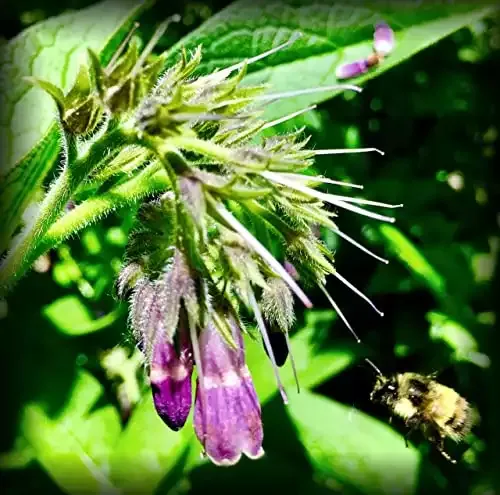


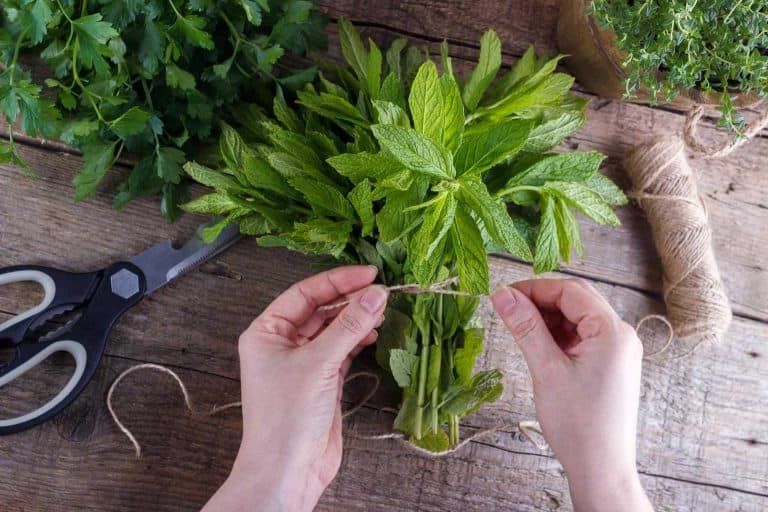
![25 Smokin’ Hot Smokehouse Ideas [DIY Plans You Can Use for Free!]](https://69be7209.flyingcdn.com/wp-content/uploads/2022/10/rural-smokehouse-cooking-food-in-the-woods-768x512.jpg)

![56 Best Gifts for Farmers, Ranchers, and Homesteaders [Useful Gift Ideas]](https://69be7209.flyingcdn.com/wp-content/uploads/2022/07/gardening-tools-make-perfect-gifts-for-farmers-768x399.jpg)
![How to Dechlorinate Tap Water for Free and at Home! [6 Ways]](https://69be7209.flyingcdn.com/wp-content/uploads/2022/12/hand-holding-a-clean-glass-of-drinking-water-from-tap-filter-768x512.jpg)
I am amazed that people actually took Comfrey internally ???? I was always told never to ingest Comfrey ????
Hi Michelle! This is a hotly debated topic 😀 My favorite herbs book by Isabell Shipard lists some fantastic research on this. It’s convinced me that comfrey is a valuable food source and medicinal plant, however, it always pays to be cautious and perform your own research 🙂 Even if you prefer not to take comfrey internally, its benefits in the garden make it well worth growing – asparagus and comfrey as companions is a match made in heaven 🙂
Thanks for dropping in, appreciate the comment!
Loved reading how you do comfrey ointment
Thanks so much Heather!